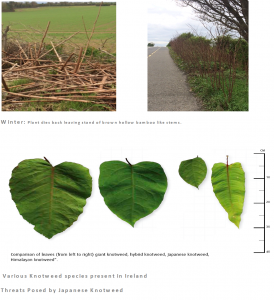Japanese Knotweed and other non native invasive species are becoming an ever more increasing problem in Ireland. It has been reported that invasive species cost the Irish economy over €200 million annually and this figure is likely to rise into the future with both increasing awareness and efforts to prevent their spread.
Japanese Knotweed is a robust perennial plant which grows rigorously with the potential to spread rapidly, growing up to 2-3m in one growing season. It has an underground rhizome system consisting of stems/roots that can stretch horizontally up to 7 meters and it can grow almost anywhere as it can tolerate extreme conditions such as low temperatures, acidic soils and waterlogged/saline environments.
Legislation
The following legislation sets out our and other landowners obligations in relation to dealing with invasive species;
Section 52 (7) (c) of the Wildlife Act, 1976, as amended,1 Which provides that ‘Any person who-(…) plants or otherwise causes to grow in a wild state in any place in the state any species of flora, or the flowers, roots, seed or spores of flora, (…) otherwise than under and in accordance with a licence granted in that behalf by the Minister shall be guilty of an offence.’
Regulation 49(2) of the European Communities (Birds and Natural Habitats) Regulations, 2011, 2 provides ‘Save in accordance with a licence (…), any person who plants, disperses, allows or causes to disperse, spreads or otherwise causes to grow scheduled plants (including Japanese Knotweed (Fallopia japonica) ,giant knotweed (Fallopia sachalinensis) and Himalayan knotweed (Persicaria wallichii)) 3 shall be guilty of an offence.
1Section 52 (7) (c) of the wildlife Act, 1976, as inserted by 56(d) of the Wildlife (Amendment) Act, 2000.
2Regulation 49(2) of the European Communities (Birds and Natural Habitats) Regulations, 2011 (S.I No. 477 of 2011).
3Part 1 of the Third Schedule of the European Communities (Birds and Natural Habitats) Regulations, 2011 (S.I No. 477 of 2011).
Identification of Japanese Knotweed
- Spring: Red buds appear first then spear like stems
- Summer: Growing very quickly up to 3 metres
- Late Summer/Early Autumn: still in flower
- Winter: Plant dies back leaving stand of brown hollow bamboo like stems

Various Knotweed species present in Ireland

Threats Posed by Japanese Knotweed
- It has the ability to grow through any existing weakness in concrete, asphalt, and other hard standing areas and so it has the potential to undermine the structural integrity of masonry walls, bridges, roads, buildings etc.
- It can increase soil erosion along river banks.
- Propagates quickly so it can colonise an area very quickly.
- Costly to remove.
- Out competes native species.
Control Measures
- As surveys of the road network in county Laois are undertaken all locations of Japanese Knotweed identified are to be recorded on maps with co-ordinates for each location.
- All infestations found on lands or property owned, managed or under the responsibility of Laois County Council is to be reported to the Area Engineer.
- Where possible the following information should be provided in the report;
- Date
- Address
- GPS Co-ordinates (If available)
- Observations/comments/descriptions as necessary
- Photos
- Give an approximation of the size of the infestation e.g. 5m length by 2m in depth = 10m2
- Markings are to be placed on the road surface where possible to identify the location in advance of the following step.
- Signage as per sample on the next page is to be installed either side of locations where it is found to advise landowners, utility companies, contractors and other service providers not to interfere with the invasive weed which could potentially lead to it further spreading.
Sample of sign to be erected at infestation locations

Treatment
- A log of all treatments undertaken is to be maintained which shall contain the following:
- Type of treatment undertaken,
- Concentration of chemical used,
- Approximate measurement of the area treated,
- Weather conditions during treatment,
- Date of treatment,
- Any other relevant observations.
A Sample Log in attached to the end of this document.
Chemical controls
Note:
Staff carrying out such tasks are to be appropriately trained and log’s completed as required. They shall familiarise themselves and co-workers with the relevant risk assessments attached for the use of chemicals and weed spraying.
When using weed killers, care must always be taken to follow the instructions on the pack to make effective and economic use of the product while minimising risks to people and the environment.
The use of certain chemicals adjacent to water sources and watercourses is prohibited and the appropriateness of a particular chemical is to be assessed prior to application.
Glyphosate
- Possibly the most effective and simplest method to tackle Japanese knotweed is with glyphosate-based weed killers. The labels of the various products generally provide recommendations for controlling Japanese knotweed however if the treatment of Japanese knotweed is not listed then data sheets are available from suppliers websites.
- Glyphosate is generally applied to the foliage and is passed internally within the plants system to all parts including the rhizome underground.
- As with other weeds, the most effective time for spraying Japanese knotweed with glyphosate is at the flowering stage in late summer. However, it is difficult to spray at this stage, when the weed is 2.1m (7ft) or more high
- A more practical approach is to allow Japanese knotweed to grow to about 90cm (3ft), which will usually be reached in May, and spray then. There will be regrowth and consequently a second application in mid-summer will be required.
- Stem injection is another option but it is not always practical. It may be suitable within environmentally protected areas and areas of high amenity value.
- Surveys of infested areas should be carried out again during September and if it has grown once more, spray again before growth begins to die down in the autumn.
- Survey again the following spring.
- Avoid spray coming into contact with garden plants. Glyphosate-treated knotweed will often produce small-leaved, bushy regrowth 50-90cm (20in-3ft) in height the following spring. This is very different in appearance to the normal plant and it is essential that this regrowth is treated.
- It usually takes at least three to four seasons to eradicate Japanese knotweed using glyphosate.
- Professional contractors will have access to more powerful weed killers that may reduce the treatment period to achieve eradication.
Prevention Measures
- Do not strim, flail or physically cut Japanese knotweed.
- Do not disturb the plant or the soil beneath it and certainly not within 7 m of the plant.
- Avoid using tracked vehicles in areas where Japanese Knotweed is present.
- Vehicles are to be thoroughly cleaned and washed down before and after leaving an area of infestation or at work sites adjacent to watercourses in order to prevent the spread of the invasive species.
- Laois County Council and contractors working on its behalf are to prepare a site specific risk assessment before any treatment operation commences. A method statement must be included making provision for a traffic management plan when working in close proximity to public roads.
- Sightings of Japanese knotweed on all lands owned, managed or in the responsibility of Laois County Council is to be reported to the Area Engineer.
Infestations on private land
Where Japanese Knotweed is indentified on private lands effort should be made to establish ownership and contact made advising the owner of its presence, their legislative requirements and of the precautions and treatment measures to be taken to eradicate the weed.
Training
All persons who use herbicides in the course of their work must receive training from a certified body which is approved by the Department of Agriculture Food and the Marine.
Those involved in managing Japanese knotweed with pesticides will need to be aware of, and comply with, legislation governing; the use of plant protection products; and, the sustainable use of pesticides.
Information relating to professional users and the register is available on the website of the Pesticide Registration and Control Divisions (PRCD) of the Department of Agriculture, Food and the Marine (DAFM):
http://www.pcs.agriculture.gov.ie/sud/professionaluserssprayeroperators/


